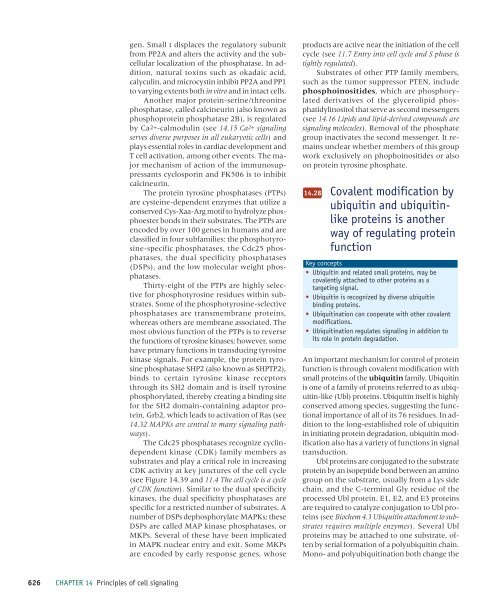Principles of cell signaling - UT Southwestern
Principles of cell signaling - UT Southwestern
Principles of cell signaling - UT Southwestern
Create successful ePaper yourself
Turn your PDF publications into a flip-book with our unique Google optimized e-Paper software.
39057_ch14_<strong>cell</strong>bio.qxd 8/28/06 5:11 PM Page 626<br />
gen. Small t displaces the regulatory subunit<br />
from PP2A and alters the activity and the sub<strong>cell</strong>ular<br />
localization <strong>of</strong> the phosphatase. In addition,<br />
natural toxins such as okadaic acid,<br />
calyculin, and microcystin inhibit PP2A and PP1<br />
to varying extents both in vitro and in intact <strong>cell</strong>s.<br />
Another major protein-serine/threonine<br />
phosphatase, called calcineurin (also known as<br />
phosphoprotein phosphatase 2B), is regulated<br />
by Ca2+-calmodulin (see 14.15 Ca2+ <strong>signaling</strong><br />
serves diverse purposes in all eukaryotic <strong>cell</strong>s) and<br />
plays essential roles in cardiac development and<br />
T <strong>cell</strong> activation, among other events. The major<br />
mechanism <strong>of</strong> action <strong>of</strong> the immunosuppressants<br />
cyclosporin and FK506 is to inhibit<br />
calcineurin.<br />
The protein tyrosine phosphatases (PTPs)<br />
are cysteine-dependent enzymes that utilize a<br />
conserved Cys-Xaa-Arg motif to hydrolyze phosphoester<br />
bonds in their substrates. The PTPs are<br />
encoded by over 100 genes in humans and are<br />
classified in four subfamilies: the phosphotyrosine-specific<br />
phosphatases, the Cdc25 phosphatases,<br />
the dual specificity phosphatases<br />
(DSPs), and the low molecular weight phosphatases.<br />
Thirty-eight <strong>of</strong> the PTPs are highly selective<br />
for phosphotyrosine residues within substrates.<br />
Some <strong>of</strong> the phosphotyrosine-selective<br />
phosphatases are transmembrane proteins,<br />
whereas others are membrane associated. The<br />
most obvious function <strong>of</strong> the PTPs is to reverse<br />
the functions <strong>of</strong> tyrosine kinases; however, some<br />
have primary functions in transducing tyrosine<br />
kinase signals. For example, the protein tyrosine<br />
phosphatase SHP2 (also known as SHPTP2),<br />
binds to certain tyrosine kinase receptors<br />
through its SH2 domain and is itself tyrosine<br />
phosphorylated, thereby creating a binding site<br />
for the SH2 domain-containing adaptor protein,<br />
Grb2, which leads to activation <strong>of</strong> Ras (see<br />
14.32 MAPKs are central to many <strong>signaling</strong> pathways).<br />
The Cdc25 phosphatases recognize cyclindependent<br />
kinase (CDK) family members as<br />
substrates and play a critical role in increasing<br />
CDK activity at key junctures <strong>of</strong> the <strong>cell</strong> cycle<br />
(see Figure 14.39 and 11.4 The <strong>cell</strong> cycle is a cycle<br />
<strong>of</strong> CDK function). Similar to the dual specificity<br />
kinases, the dual specificity phosphatases are<br />
specific for a restricted number <strong>of</strong> substrates. A<br />
number <strong>of</strong> DSPs dephosphorylate MAPKs; these<br />
DSPs are called MAP kinase phosphatases, or<br />
MKPs. Several <strong>of</strong> these have been implicated<br />
in MAPK nuclear entry and exit. Some MKPs<br />
are encoded by early response genes, whose<br />
products are active near the initiation <strong>of</strong> the <strong>cell</strong><br />
cycle (see 11.7 Entry into <strong>cell</strong> cycle and S phase is<br />
tightly regulated).<br />
Substrates <strong>of</strong> other PTP family members,<br />
such as the tumor suppressor PTEN, include<br />
phosphoinositides, which are phosphorylated<br />
derivatives <strong>of</strong> the glycerolipid phosphatidylinositol<br />
that serve as second messengers<br />
(see 14.16 Lipids and lipid-derived compounds are<br />
<strong>signaling</strong> molecules). Removal <strong>of</strong> the phosphate<br />
group inactivates the second messenger. It remains<br />
unclear whether members <strong>of</strong> this group<br />
work exclusively on phophoinositides or also<br />
on protein tyrosine phosphate.<br />
14.28<br />
Covalent modification by<br />
ubiquitin and ubiquitinlike<br />
proteins is another<br />
way <strong>of</strong> regulating protein<br />
function<br />
Key concepts<br />
• Ubiquitin and related small proteins, may be<br />
covalently attached to other proteins as a<br />
targeting signal.<br />
• Ubiquitin is recognized by diverse ubiquitin<br />
binding proteins.<br />
• Ubiquitination can cooperate with other covalent<br />
modifications.<br />
• Ubiquitination regulates <strong>signaling</strong> in addition to<br />
its role in protein degradation.<br />
An important mechanism for control <strong>of</strong> protein<br />
function is through covalent modification with<br />
small proteins <strong>of</strong> the ubiquitin family. Ubiquitin<br />
is one <strong>of</strong> a family <strong>of</strong> proteins referred to as ubiquitin-like<br />
(Ubl) proteins. Ubiquitin itself is highly<br />
conserved among species, suggesting the functional<br />
importance <strong>of</strong> all <strong>of</strong> its 76 residues. In addition<br />
to the long-established role <strong>of</strong> ubiquitin<br />
in initiating protein degradation, ubiquitin modification<br />
also has a variety <strong>of</strong> functions in signal<br />
transduction.<br />
Ubl proteins are conjugated to the substrate<br />
protein by an isopeptide bond between an amino<br />
group on the substrate, usually from a Lys side<br />
chain, and the C-terminal Gly residue <strong>of</strong> the<br />
processed Ubl protein. E1, E2, and E3 proteins<br />
are required to catalyze conjugation to Ubl proteins<br />
(see Biochem 4.3 Ubiquitin attachment to substrates<br />
requires multiple enzymes). Several Ubl<br />
proteins may be attached to one substrate, <strong>of</strong>ten<br />
by serial formation <strong>of</strong> a polyubiquitin chain.<br />
Mono- and polyubiquitination both change the<br />
626 CHAPTER 14 <strong>Principles</strong> <strong>of</strong> <strong>cell</strong> <strong>signaling</strong>
















